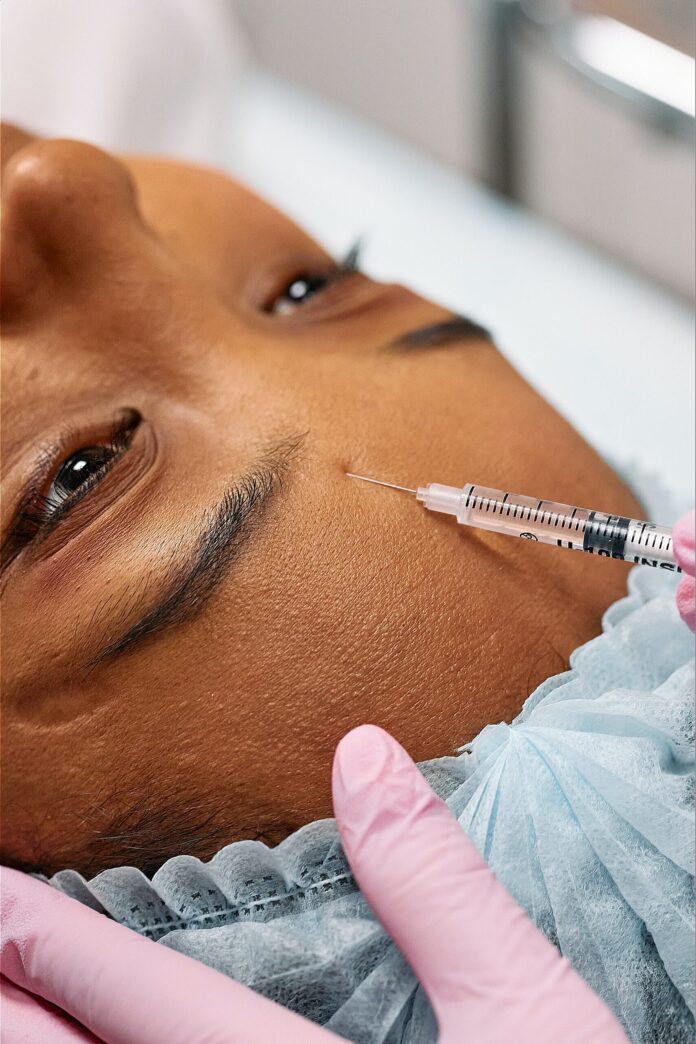Botox still seems to be one of the most commonly used, non-surgical, available cosmetic treatments, for helping to minimize such aging woes as crow’s feet, forehead, lip and frown lines. As a matter of fact, from 2000 to 2020, the number of annual Botox injections in the U.S. alone increased by a whopping 459%.
The American Society of Plastic Surgery reported that 80% of Botox users were caucasian in 2020 while only 4% of Botox injections were administered to Black patients – representing a very small percentage of total Botox users. In the Black community, however, the notion of indulging in many of the aesthetic treatments for skin rejuvenation has been negative.There are those in the community who believe Botox usage is simply an attempt to copy Eurocentric beauty standards. There are many Black patients who are also blessed with skin that doesn’t manifest with wrinkles at all, and don’t really have forehead lines like many caucasians do. And since Botox was originally developed to treat forehead lines, it has traditionally not been a widely used treatment in the Black community.
So, to those folks who feel they need a little facial tune-up (don’t judge), here are all of the facts you need to know about Botox.
What is Botox?
Clostridium botulinum, the bacterium from which Botox is derived is found in many natural settings, including soil, lakes, and forests. The not so nice explanation for the substance is that it is related to a naturally occurring poison that can sometimes be found at dangerous levels in contaminated meat products. Botox has been described as the deadliest substance known to man and can be injected, ingested or inhaled quickly causing paralysis and eventually, respiratory failure.
Before Botox became a cosmetic anti-aging wonder substance, it was, and is, used to treat a variety of medical issues. It has been rather effective in treating such health-related ailments as chronic migraines, uncontrollable blinking, leaky bladder, strabismus (crossed eyes) and eye squints. Botox has also been used off-label (not approved) to treat conditions like cerebral palsy, excessive sweating, hay fever, and achalasia (throat problem that makes swallowing difficult).
How can a poison be used as a medicine?
The same properties that make botulinum toxins harmful to the nervous system can also be used to treat a number of physical disorders involving the neuromuscular system. As botulinum toxin biological activity (mode of action) is relatively well understood, treatments have been developed for administering the right amount (proper dose) in just the right location of the body to treat various medical conditions, with minimal side effects. Following the successful completion of the U.S. Food and Drug Administration (FDA) requirements for new drug development, Allergan markets Botox for cosmetic purposes and the treatment of more serious medical conditions.
Dermatologists agree that wrinkles and facial volume loss do not discriminate and these changes can occur with aging across all ethnicities and skin colors.
How does Botox work?
Botox can be skillfully injected to relax the facial muscles in order to minimize lines and wrinkles in skin of any color. The toxin is injected directly into neuromuscular tissue and can typically take up to 72 hours for the results to be evident or in rare cases, five days. However, if Botox spreads from the site of injection, then all red flags go up!
What are the side effects of Botox?
Even though Botox injections are well tolerated, there are side effects to look out for:
Headache
General malaise (bad feelings) or flu-like illness
Nausea
Numbness
Mild pain or swelling at the injection site
Paralysis of nearby muscles
Upper eyelid or brow drooping
Trouble swallowing
Trouble breathing
Hoarseness
Gallbladder dysfunction
Blurred or double vision
Decreased eyesight or blindness
Wheezing
Neck weakness
Word to the wise
Botched Botox jobs are pretty commonplace these days and unfortunately, many people put their trust in individuals, who do NOT know what they’re doing. These unlicensed practitioners are playing guessing games with administering Botox and many of whom you’ll typically find at Botox parties. If you are getting Botox injections at parties, you are increasing your chance of having a botched Botox injection.
When people risk being injected with Botox at places like spas and gyms, for example, they don’t know what they’re truly receiving, how old the product is, and whether the injector knows what they’re doing. Medical experts advise anyone who is considering using Botox to just stick to ‘the core four’ for safety’s sake: a board-certified physician who is either a dermatologist, a plastic surgeon, an ear-nose-and-throat doctor, or an ophthalmologist.
Looking for a physician who administers Botox? Look no further! www.botoxcosmetic.com











